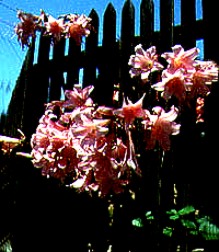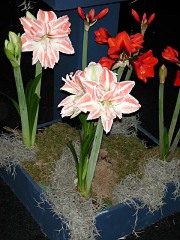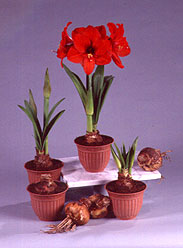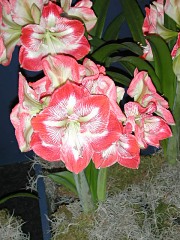
Amaryllis - Getting Ready for Next Year
Buy an amaryllis and you will have been sold a Hippeastrum - but not to worry!
We became used to the name amaryllis before botanists realised that there was an older name that really needed to be used to satisfy the rules that govern plant nomenclature.
| There is one bulb that is still properly called by that name, the magnificent South African, summer-flowering perennial, Amaryllis belladonna. It is hardy to zone 8 or further north with a heavy mulch, but finds the heat of zone 10 trying, so that garden use is best in zones 7-9. Here the bulbs can stay in the ground, and will get better year after year. The bulbs are planted with their neck just at ground level in a spot getting full sun. Leaves develop in the spring, but die down in summer. Nothing is then visible above ground for six to eight weeks when a leafless stalk develops rapidly and opens a crown of pink fragrant flowers. |
 |
|
Netherlands Flower Bulb Information
Center
|
|
|
Now, what about the amaryllis that everyone loves as a holiday flower. The Hippeastrum, that is, but let's use the more familiar name from now on. These have been
favorite subjects for breeding for many years. The Dutch have produced
a range of cultivars that are essentially foolproof for pot culture,
and South African nurseries are now coming on very strongly. |
 |
Work is proceeding in many directions - all variations of the red, pink and white color range, including striped and picotee-edged forms, dwarf plants and giants, narrow petals, broad overlapping petals,double flowers, numerous flowers on each stalk and multiple stalks from each bulb.Each one is more spectacular than the last, and a show of several hundred varieties will make your head spin. |
What happens when the bulb that was so beautiful as a gift finally loses its flowers? It is remarkably easy to carry the plants through the spring and summer, and with a little manipulation, bring them into glorious bloom again the following winter.
The International Flower
Bulb Centre/Netherlands Flower Bulb Information Center explains how to
become an expert in this article, reprinted here with their permission
[and my thanks-editor].
AMARYLLIS RE-BLOOM
Details to the nth Degree! It's actually very easy to get amaryllis flower
bulbs to re-bloom next year:
Following are OPTIMAL conditions.For
most people, ideal conditions are not always possible. Don't worry! Just
get as close as you can to the following - the amaryllis is a trouper
and will do its best to accommodate.
|
 |
|
Bare bulb to brazen bloom
|
Here are the steps in more detail:
- Fertilize amaryllis regularly
during the growth cycle starting one month after planting (when active
growth is underway). Use regular houseplant food in either a complete
NPK liquid fertilizer, applied 2x per month, or a long-lasting, balanced,
timed-release fertilizer,applied as needed.
- After the bloom cycle finishes,
cut off the stems just above the bulb nose. Continue to grow the strappy-leaved
plant in a warm spot in bright light, watering regularly to keep soil
moist. Continue to fertilize as above.
- Amaryllis may be moved out-of-doors
over the summer (you can either sink the whole pot into the soil or
keep it as a container plant).
- Bring inside in September
or before first frost. Keeping the bulb growing indoors over summer
is also an option: kept in bright light, southern exposure is best.
Don't let it dry out.
- To re-flower the bulb: in
September, stop watering and place the bulb (still in pot) in a dry
cool place for 10 - 12 weeks. (It is also OK to keep the plant growing,
not dormant if you think you can keep it at a cool temperature around
55 to 60 F. This temperature is what is important, being similar to
that experienced in its native environment.) But why bother, you want
to repot them anyway. So just stop watering them, keep them relatively
cool for 10 - 12 weeks and repot.
- Do not store any bulbs in
a refrigerator with fruit (such as apples) which emit ethylene gas.
This naturally occurring gas damages flower development.
- After 10 - 12 weeks (by now
it is November/December) remove the bulb from the original pot. Gently
clean off old foliage and any old roots. Leave healthy roots intact
(these will be firm and plump).
- Repot in fresh soil, leaving
the "shoulders" of the bulb exposed (the top 1/3 of the bulb). Use the
same pot or a pot sized slightly larger around than the bulb itself.
Usually a 6-inch pot is perfect for one bulb. For a more dramatic display
of flowers, plant three or more bulbs with flowers of the same color
together in one pot sized large enough to hold them. All pots must have
drainage holes.
- To initiate growth, a warm
site (for example 70 to 75 F) is best. Cooler sites in the house (such
as a window sill) are fine once growth commences. Water thoroughly to
"start up." In subsequent weeks, water sparingly.
- Once growth emerges, water regularly to keep soil moist (never soggy) and resume a fertilizing program. The amaryllis will bloom again, about 8 weeks after the first watering.
NOTE: ZONES 7-10: OUTDOOR PLANTING In warmer areas amaryllis can be grown outdoors. Bulbs may be planted outside in spring after threat of frost is past. Plant the bulb with the base of the bulb 8-inches deep (so the top is about 3-inches deep). Protect over-winter with 2- to 3-inches of mulch. Amaryllis fare best in climates with approximately 9 months of temperatures of 70 F and up and 3 months of less than 60 F. Expect one bloom cycle per year, in late spring.
[Editor's note: those of us in the South know that there are several colors that have been grown for many years and passed on from gardener to gardener. These "granny bulbs" produce their glorious show each spring with no care or special treatment, no matter what the winter temperature has been. I give mine a moderate dose of whatever fertiliser is to hand after the flowers fade in April. Then the only chore is to thin the bed every few years, and find friends with whom to share the bulbs. The time of year for this disturbance doesn't seem to be critical, but may be best before the flush of new roots that come in the fall have made their appearance.]
Back to Table of Contents
